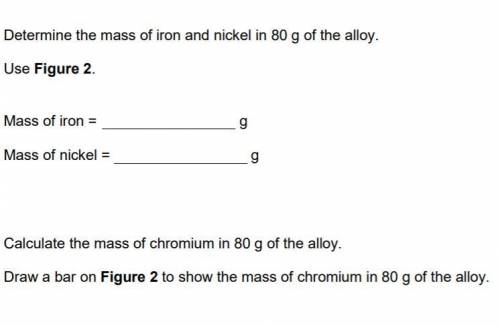
Physics, 31.01.2021 23:20 adriandehoyos1p3hpwc
One alloy contains iron, chromium and nickel. Figure 1 shows the mass of iron and the mass of nickel in 80 g of this alloy.

Answers: 3


Another question on Physics

Physics, 21.06.2019 15:10
What if? if the temperature near the cliff suddenly falls to 0°c, reducing the speed of sound to 331 m/s, what would the initial speed of the rock have to be (in m/s) for the soccer player to hear the sound of the splash 2.90 s after kicking the rock?
Answers: 3

Physics, 22.06.2019 12:10
Consider a one meter long horizontal pipe with a constant 100 cm^2 cross sectional area. water flows rightward into the pipe at x = 0 with flow velocity 02m/sec at every point within the pipe intake area. at x=1, the rightward flow rate is 0.192 m/sec. assume the water is a conserved quantity in the pipe, so there must be a leak (a sink) somewhere in the pipe. 1. compute net volumetric flow of the source if the system to be in equilibrium. 2. now assume the pipe in the problem has no leaks. compute the net volumetric rate of change for the system.
Answers: 3

Physics, 22.06.2019 19:30
Amass m = 74 kg slides on a frictionless track that has a drop, followed by a loop-the-loop with radius r = 18.4 m and finally a flat straight section at the same height as the center of the loop (18.4 m off the ground). since the mass would not make it around the loop if released from the height of the top of the loop (do you know why? ) it must be released above the top of the loop-the-loop height. (assume the mass never leaves the smooth track at any point on its path.) 1. what is the minimum speed the block must have at the top of the loop to make it around the loop-the-loop without leaving the track? 2. what height above the ground must the mass begin to make it around the loop-the-loop? 3. if the mass has just enough speed to make it around the loop without leaving the track, what will its speed be at the bottom of the loop? 4. if the mass has just enough speed to make it around the loop without leaving the track, what is its speed at the final flat level (18.4 m off the ground)? 5. now a spring with spring constant k = 15600 n/m is used on the final flat surface to stop the mass. how far does the spring compress?
Answers: 3

Physics, 22.06.2019 23:10
Atorque acting on an object tends to produce a. equilibrium b. rotation c. linear motion d. velocity e. a center of gravity
Answers: 2
You know the right answer?
One alloy contains iron, chromium and nickel. Figure 1 shows the mass of iron and the mass of nickel...
Questions


Business, 30.06.2019 09:10


Geography, 30.06.2019 09:10

Mathematics, 30.06.2019 09:10


Mathematics, 30.06.2019 09:10

History, 30.06.2019 09:10


History, 30.06.2019 09:10



English, 30.06.2019 09:10

Chemistry, 30.06.2019 09:10


Biology, 30.06.2019 09:10

Mathematics, 30.06.2019 09:10


Mathematics, 30.06.2019 09:10

 grams
grams




